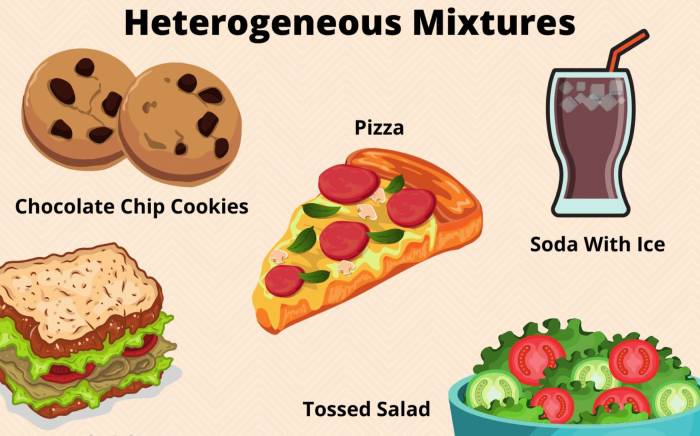The term heterogeneous mixture is used to describe a mixture with a non-uniform composition. At least two phases that remain separated from each other and have clearly identifiable properties remain in different regions, with the composition varying from one region to another. When you examine a sample of a mixture that is heterogeneous, you will be able to see the different components that make up the mixture.
Heterogeneous mixtures are somewhat different from homogeneous mixtures in the fields of physical chemistry and materials science. It should be noted that a homogeneous mixture refers to one in which all the components are located in a single phase, while a heterogeneous mixture is composed of components located in different phases.

Table of Contents
Examples of Heterogeneous Mixtures
- As the name implies, concrete is a heterogeneous mixture of aggregates, namely cement, and water.
- There is a heterogeneous mixture of sugar and sand in nature. It is possible to identify tiny sugar crystals and sand particles if you look closely at the samples.
- There is a heterogeneous mixture between the ice cubes in cola and the liquid. It is important to remember that ice and soda are in two distinct phases of matter (solid and liquid).
- There is a heterogeneous mixture between salt and pepper.
- It is important to keep in mind that chocolate chip cookies are a heterogeneous mixture. As you bite into a cookie, you may not receive the same number of chips as you would if you took another bite at the same time.
- There is no doubt that soda is a heterogeneous mixture. There are three main ingredients in it, which are water, sugar, and carbon dioxide, which forms bubbles. In spite of the fact that sugar, water, and flavorings might form a chemical solution, there is no uniform distribution of carbon dioxide bubbles throughout the liquid.
Homogeneous Vs. Heterogeneous Mixtures
The components of a homogeneous mixture will always appear in the same proportion no matter where you take a sample from in a homogeneous mixture. Contrary to this, samples taken from different parts of a heterogeneous mixture may contain different proportions of the components of the mixture.
As an example, if you pick up a handful of M&Ms from a bag of green M&Ms, every single candy that you pick from the bag will be green. In addition, if you take another handful of candies, you will once again find that all of the candies are green. There is a homogeneous mixture inside that bag. There is a chance that if you take a handful of candy from a regular bag of M&Ms, the proportion of colors you get may be different from what you would get if you took a second handful of candy. A heterogeneous mixture is what we are dealing with here.
As a general rule, whether a mixture is homogeneous or heterogeneous depends on the scale at which the sample is taken. Using the candy example as an example, even though you may get a different sample of candy colors if you compare handfuls from one bag with handfuls from another bag, the mixture may be homogeneous if you compare all the colors of candies from one bag with all the colors of candies from another bag. In the case of comparing the ratio of colors from 50 bags of candy to another 50 bags of candy, chances are good that there won’t be a statistically significant difference between the ratio of colors between the two bags of candy.
The same is true in chemistry as well. As you compare the composition of smaller and smaller samples, a mixture may appear homogeneous on a macroscopic scale, but once you compare its composition on a microscopic scale, the mixture will appear heterogeneous.
Homogenization
It is possible to make a heterogeneous mixture into a homogeneous mixture through a process known as homogenization. As an example of homogenization, homogenized milk is processed in such a way that the components of the milk are stable and do not separate during the processing process.
The natural milk, on the other hand, despite the fact that it may appear homogeneous when shaken, is not stable and readily separates into layers when left to stand.
